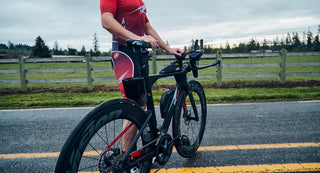As technology continues to evolve, it permeates all aspects of our lives, including our beloved bikes. One of the most notable advancements in cycling technology is electronic shifting, which has opened up a new world of super-precise shifting (sometimes with a high performance price tag). So what exactly are the benefits and drawbacks of this innovation? Let’s take a closer look at the showdown between electronic and mechanical shifting.
What is Electronic Shifting?
Electronic shifting replaces the traditional mechanical cables and levers with electronic switches and motors. When you press a button, a signal is sent to a derailleur, which then moves the chain with precision and speed. Systems like Shimano Di2 and SRAM eTap are some of the most popular electronic shifting systems on the market today. Our SP 1.1e, 1.3 and 1.4 triathlon bikes and our Rogue Apex, Rival, Force and Red builds all feature SRAM electronic shifting. While we don't offer standard Di2 builds, send us a message and we can do a special build for you!
The Pros of Electronic Shifting
Precision and Accuracy
One of the most significant advantages of electronic shifting
is its precision. Electronic systems can fine-tune shifts with incredible accuracy, reducing the chances of mis-shifts or chain drops. This precision is especially beneficial during races or in technical terrains where reliable gear changes are crucial. As you go up the line of electronic shifting, the precision increases and weight decreases.

In comparison, mechanical shifting relies on cables that can stretch over time and may need more involved adjustments to get precise shifting every time. We dive a bit deeper into the maintenance a bit later in this blog.
Easy Shifting
With electronic shifting, changing gears requires minimal effort. A light press of a button is all it takes, making it easier for riders with limited hand strength or those who ride long distances. My mom has arthritis in her hands, and changing to electronic shifting made riding a lot more enjoyable (and safer!) for her. This ease of use can be a game-changer for long rides or challenging climbs that require a lot of shifting.
For triathlon specifically, wireless shifting with the SRAM AXS system has made shifting in multiple places -- not just at the end of the aero extensions -- finally possible. Add a set of blips to your base bar and now you are able to shift easily while climbing or descending without needing to take your hands off of the bars and shift them to the extensions. With blips, you can add extra shifting options practically anywhere!
Programmability
Electronic systems often come with software that allows riders to customize their shifting preferences. You can program shift patterns, adjust the speed of shifts, and even set up multi-shift options, where holding the button shifts through multiple gears. This customization can enhance your riding experience, making it more tailored to your specific needs and style.
SRAM and Shimano both have apps to help you know everything and adjust everything without needing to troubleshoot any issues yourself. Check batteries, adjust shifting, personalize shift modes and configurations, and more right from your smartphone.
Consistency in All Conditions
Electronic shifting is less affected by environmental factors such as mud, rain, or cold temperatures. In contrast, electronic systems maintain consistent performance as systems are waterproof and wires are sealed from the elements and largely held inside the frame, providing protection from the elements or contamination and reliable shifting regardless of the weather or terrain.
Cleaner Aesthetics and Reduced Maintenance
Honestly, this is the part that largely convinced me to switch over to electronic shifting. Maintenance is as simple as keeping batteries charged and indexing shifting (via app button) as needed. There is no cable stretch or messing with bolts and tools to make adjustments. Most importantly - there's no risk of the dreaded cable snap.
If this isn't enough to convince you, electronic shifting just look cleaner because you don't have traditional cables and housing. Looks may not be the most important thing, but hey, it's something.
The Cons
CostOne of the most significant drawbacks of electronic shifting is the cost. Electronic groupsets are considerably more expensive than their mechanical counterparts. This higher price point can be a barrier for many cyclists, especially those new to the sport or on a tight budget. At the end of the day, mechanical shifting will absolutely do the trick.
Battery Dependence
Electronic systems rely on batteries, which means they need to be charged periodically. Forgetting to charge your system could leave you stuck in one gear, potentially ruining a ride or race. If you're especially worried about this added responsibility, we recommend buying a few extra batteries (if you use SRAM) and keeping those extras always charged or even pop an extra battery in your bag during a ride or race! The nice thing about having two different batteries as well for SRAM is if you do accidentally forget to charge a battery, you can swap the batteries around to prioritize the rear shifting and pick your gear in the front. It's not perfect, but it's an option!
With mechanical, it's one less "to do" in your pre-ride checklist.

Potential for Technical Issues
With more technology comes the potential for more technical issues. Electronic shifting systems can be complex and can be more involved to troubleshoot and repair versus age-old and well known mechanical shifting. If something goes wrong that the app can't fix, it might require a visit to a specialized bike shop, which could be both time-consuming and costly.
So which one is better?
Electronic shifting is a significant advancement in cycling technology, offering precision, ease of use, and customization. However, it comes with its own set of challenges, including higher costs, battery dependency, and potential technical issues. For some, the benefits of smoother, more reliable shifting and the ability to customize and easily maintain the system will outweigh the drawbacks. For others, the simplicity and affordability of mechanical shifting will remain more appealing.
Ultimately, the choice between electronic and mechanical shifting comes down to personal preference, riding style, and budget. As with any technology, it’s essential to weigh the pros and cons to determine what works best for you. Whether you embrace electronic shifting or stick with mechanical, the most important thing is to enjoy the ride. Happy cycling!






